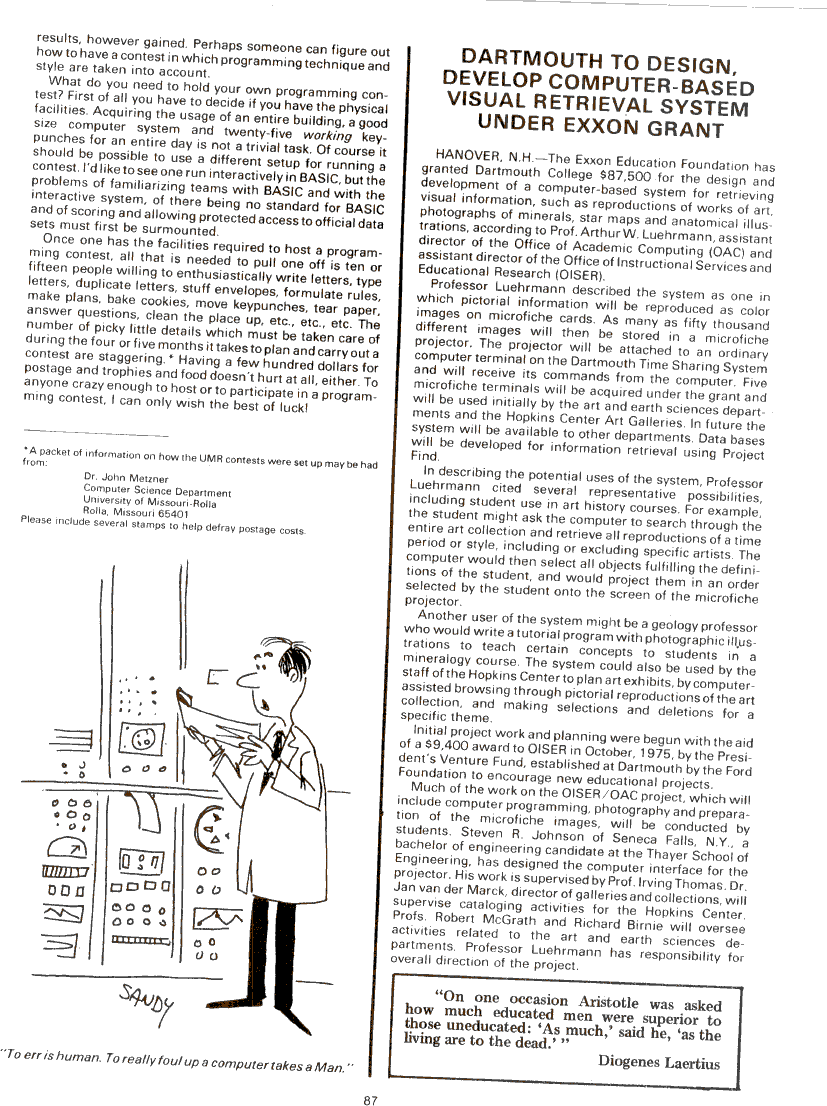The Best of Creative Computing Volume 2 (published 1977)
Dartmouth To Design, Develop Computer-Based Visual Retrieval System Under Exxon Grant (computer for retrieving visual information)

results, however gained. Perhaps someone can figure out how to have a contest in
which programming technique and style are taken into account.
What do you need to hold your own programming contest? First of all you have to
decide if you have the physical facilities. Acquiring the usage of an entire
building, a good size computer system and twenty-five working keypunches for an
entire day is not a trivial task. Of course it should be possible to use a
different setup for running a contest. I'd like to see one run interactively in
BASIC, but the problems of familiarizing teams with BASIC and with the
interactive system, of there being no standard for BASIC and of scoring and
allowing protected access to official data sets must first be surmounted.
Once one has the facilities required to host a programming contest, all that is
needed to pull one off is ten or fifteen people willing to enthusiastically
write letters, type letters, duplicate letters, stuff envelopes, formulate
rules, make plans, bake cookies, move keypunches, tear paper, answer questions,
clean the place up, etc., etc., etc. The number of picky little details which
must be taken care of during the four or five months it takes to plan and carry
out a contest are staggering.* Having a few hundred dollars for postage and
trophies and food doesn't hurt at all, either. To anyone crazy enough to host or
to participate in a programming contest, I can only wish the best of luck!
* A packet of information on how the UMR contests were set up may be had from:
Dr. John Metzner
Computer Science Department
University of Missouri-Rolla
Rolla, Missouri 65401
Please include several stamps to help defray postage costs.
[image]
"To err is human. To really foul up a computer takes a Man."
***
DARTMOUTH TO DESIGN, DEVELOP COMPUTER-BASED VISUAL RETRIEVAL SYSTEM UNDER EXXON
GRANT
HANOVER, N.H. - The Exxon Education Foundation has granted Dartmouth College
$87,500 for the design and development of a computer-based system for retrieving
visual information, such as reproductions of works of art, photographs of
minerals, star maps and anatomical illustrations, according to Prof. Arthur W.
Luehrmann, assistant director of the Office of Academic Computing (OAC) and
assistant director of the Office of Instructional Services and Educational
Research (OISER).
Professor Luehrmann described the system as one in which pictorial information
will be reproduced as color images on microfiche cards. As many as fifty
thousand different images will then be stored in a microfiche projector. The
projector will be attached to an ordinary computer terminal on the Dartmouth
Time Sharing System and will receive its commands from the computer. Five
microfiche terminals will be acquired under the grant and will be used initially
by the art and earth sciences departments and the Hopkins Center Art Galleries.
In future the system will be available to other departments. Data bases will be
developed for information retrieval using Project Find.
In describing the potential uses of the system, Professor Luehrmann cited
several representative possibilities, including student use in art history
courses. For example, the student might ask the computer to search through the
entire art collection and retrieve all reproductions of a time period or style,
including or excluding specific artists. The computer would then select all
objects fulfilling the definitions of the student, and would project them in an
order selected by the student onto the screen of the microfiche projector.
Another user of the system might be a geology professor who would write a
tutorial program with photographic illustrations to teach certain concepts to
students in a mineralogy course. The system could also be used by the staff of
the Hopkins Center to plan art exhibits, by computer-assisted browsing through
pictorial reproductions of the art collection, and making selections and
deletions for a specific theme.
Initial project work and planning were begun with the aid of a $9,400 award to
OISER in October, 1975, by the President's Venture Fund, established at
Dartmouth by the Ford Foundation to encourage new educational projects.
Much of the work on the OISER/OAC project, which will include computer
programming, photography and preparation of the microfiche images, will be
conducted by students. Steven R. Johnson of Seneca Falls, N.Y., a bachelor of
engineering candidate at the Thayer School of Engineering, has designed the
computer interface for the projector. His work is supervised by Prof. Irving
Thomas. Dr. Jan van der Marck, director of galleries and collections, will
supervise cataloging activities for the Hopkins Center. Profs. Robert McGrath
and Richard Birnie will oversee activities related to the art and earth sciences
departments. Professor Luehrmann has responsibility for overall direction of the
project.
***
"On one occasion Aristotle was asked how much educated men were superior to
those uneducated: 'As much,' said he, 'as the living are to the dead.' "
Diogenes Laertius


